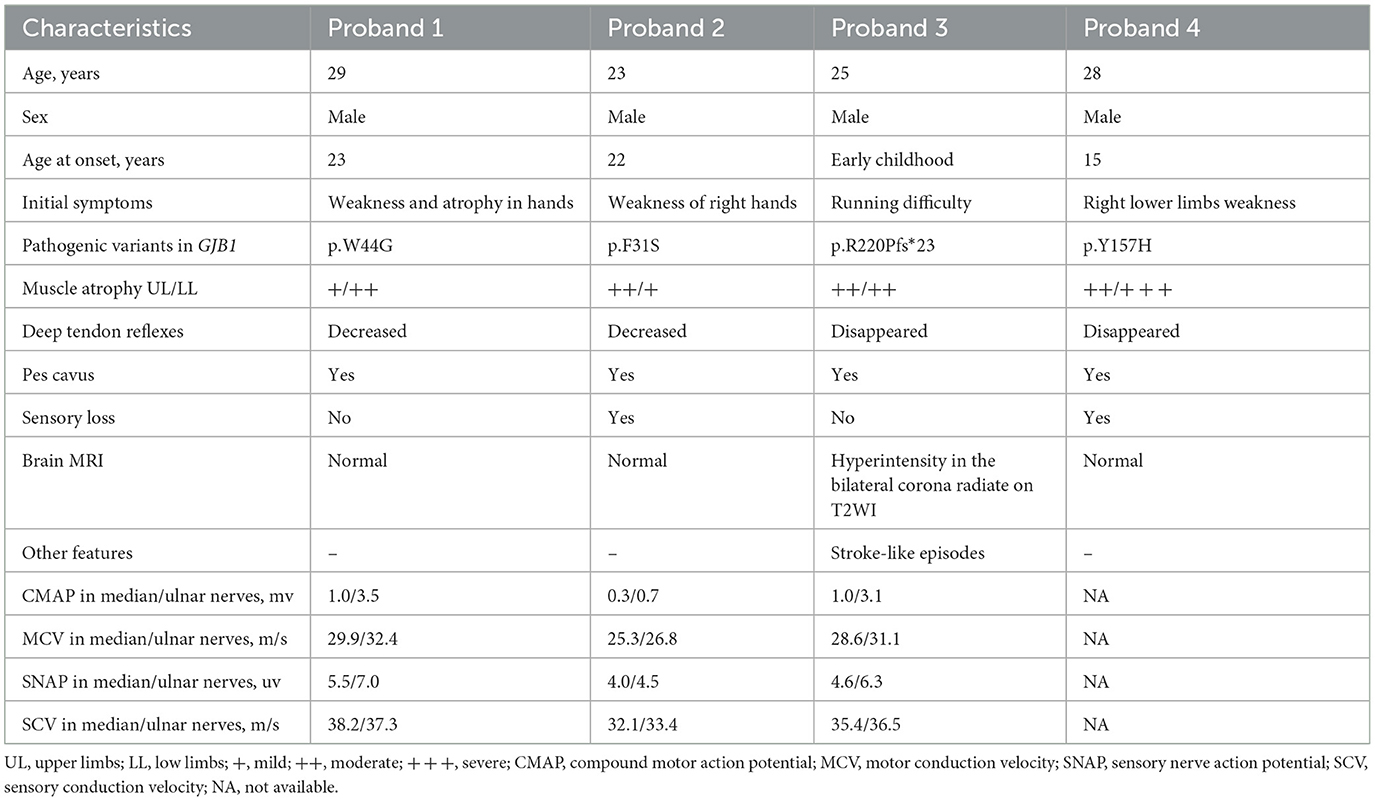- 1Department of Medical Genetics, School of Basic Medicine, Tongji Medical College, Huazhong University of Science and Technology, Wuhan, China
- 2Department of Neurology, Union Hospital, Tongji Medical College, Huazhong University of Science and Technology, Wuhan, China
A corrigendum on
Novel mutations in GJB1 trigger intracellular aggregation and stress granule formation in X-linked Charcot-Marie-Tooth Disease
by Chu, F., Xu, J., Wang, Y., Li, Y., Wang, Y., Liu, Z., and Li, C. (2022). Front. Neurosci. 16:972288. doi: 10.3389/fnins.2022.972288
In the published article, there was an error in “Table 1” as published. We are correcting the error in the original Table 1, i.e., the p.R164Q mutation we reported should be corrected as p.Y157H. The corrected “Table 1” and its caption “The clinical presentations and genetic analysis of four CMT probands” appear below.
In the published article, there was an error. The mutation p.R164Q we reported should be corrected as p.Y157H. A correction has been made to “Pages 1, 4, 6, and 12”.
This sentence previously stated:
Page 1. Abstract
“Using targeted exome-sequencing, we investigated four CMT families from central-southern China and identified two novel missense variants (p.F31S and p.W44G) and two previously reported variants (p.R220Pfs*23 and p.R164Q) of GJB1.”
Page 4. Results section, paragraph 1
“After tering and validation by Sanger sequencing, four probable pathogenic variants, including two variants previously reported as pathogenfilic variants (c.469T>C, p.R164Q, Li et al., 2016 and c.657dupC, p.R220Pfs*23) (Lu et al., 2017) and two novel variants (c.130T>C, p.F31S and c.92T>C, p.W44G), were identified in four CMT families (Figure 1).”
Page 6, right column, paragraph 1
“The proband 4 (III:2) was a 28-year-old male, carrying the p.R164Q variant in GJB1, who presented with right lower limb weakness at the age of 15.”
Page 6, right column, paragraph 2
“Since functional alternation by R164Q variation has been briefly explored previously (Li et al., 2016), we have not included this mutation in our study.”
Page 12, Discussion section, paragraph 1
“Using targeted exome-sequencing, we identified two known GJB1 mutations (p.R164Q and p.R220Pfs*23) and two novel pathogenic variants in GJB1 (p.F31S and p.W44G) among four CMT families in central-southern China. F31S and W44G were first found in our cohort, expanding the mutation spectrum in GJB1-CMT1X.”
Page 12, Discussion section, paragraph 1
“Both variations of R164Q and R220Pfs*23 have been previously reported, whereas only the R164Q mutation has been briefly explored functionally in vitro.”
The corrected sentence appears below:
Page 1. Abstract
“Using targeted exome-sequencing, we investigated four CMT families from central-southern China and identified two novel missense variants (p.F31S and p.W44G) and two previously reported variants (p.R220Pfs*23 and p.Y157H) of GJB1.”
Page 4. Results section, paragraph 1
“After filtering and validation by Sanger sequencing, four probable pathogenic variants, including two variants previously reported as pathogenic variants (c.469T>C, p.Y157H, (Li et al., 2016) and c.657dupC, p.R220Pfs*23) (Lu et al., 2017) and two novel variants (c.130T>C, p.F31S and c.92T>C, p.W44G), were identified in four CMT families (Figure 1).”
Page 6, right column, paragraph 1
“The proband 4 (III:2) was a 28-year-old male, carrying the p.Y157H variant in GJB1, who presented with right lower limb weakness at the age of 15.”
Page 6, right column, paragraph 2
“Since functional alternation by Y157H variation has been briefly explored previously (Li et al., 2016), we have not included this mutation in our study.”
Page 12, Discussion section, paragraph 1
“Using targeted exome-sequencing, we identified two known GJB1 mutations (p.Y157H and p.R220Pfs*23) and two novel pathogenic variants in GJB1 (p.F31S and p.W44G) among four CMT families in central-southern China. F31S and W44G were first found in our cohort, expanding the mutation spectrum in GJB1-CMT1X.”
Page 12, Discussion section, paragraph 1
“Both variations of Y157H and R220Pfs*23 have been previously reported, whereas only the Y157H mutation has been briefly explored functionally in vitro.”
The authors apologize for this error and state that this does not change the scientific conclusions of the article in any way. The original article has been updated.
Publisher's note
All claims expressed in this article are solely those of the authors and do not necessarily represent those of their affiliated organizations, or those of the publisher, the editors and the reviewers. Any product that may be evaluated in this article, or claim that may be made by its manufacturer, is not guaranteed or endorsed by the publisher.
References
Li, L. X., Zhao, S. Y., Liu, Z. J., Ni, W., Li, H. F., Xiao, B. G., et al. (2016). Improving molecular diagnosis of Chinese patients with Charcot-Marie-Tooth by targeted next-generation sequencing and functional analysis. Oncotarget 7, 27655–27664. doi: 10.18632/oncotarget.8377
Keywords: GJB1, gap junction, aggregation, stress granule, Charcot-Marie-Tooth
Citation: Chu F, Xu J, Wang Y, Li Y, Wang Y, Liu Z and Li C (2023) Corrigendum: Novel mutations in GJB1 trigger intracellular aggregation and stress granule formation in X-linked Charcot-Marie-Tooth Disease. Front. Neurosci. 17:1282954. doi: 10.3389/fnins.2023.1282954
Received: 25 August 2023; Accepted: 30 August 2023;
Published: 12 September 2023.
Approved by:
Frontiers Editorial Office, Frontiers Media SA, SwitzerlandCopyright © 2023 Chu, Xu, Wang, Li, Wang, Liu and Li. This is an open-access article distributed under the terms of the Creative Commons Attribution License (CC BY). The use, distribution or reproduction in other forums is permitted, provided the original author(s) and the copyright owner(s) are credited and that the original publication in this journal is cited, in accordance with accepted academic practice. No use, distribution or reproduction is permitted which does not comply with these terms.
*Correspondence: Chuanzhou Li, Y2h1YW56aG91bGlAaHVzdC5lZHUuY24=; Zhijun Liu, MjAxN3hoMDM1MUBodXN0LmVkdS5jbg==
†These authors have contributed equally to this work
 Fan Chu1†
Fan Chu1† Chuanzhou Li
Chuanzhou Li